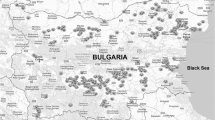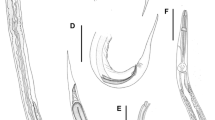Abstract
Haycocknema perplexum n. g., n. sp. (Nematoda: Robertdollfusidae) is described from a man in Tasmania, Australia. Adult male and female nematodes and larvae were recovered from myofibres following biopsy of the right vastus lateralis muscle and were associated with a polymyositis. H. perplexum is distinguished from all other genera of the Muspiceoidea by the presence of a large amorphous “cell” supporting a granule-filled, flask- or gourd-shaped reservoir in the rectal region of mature and gravid female nematodes, often containing one or more large, refractile, thick-rimmed “globules” on the external surface of the reservoir, by the small number of ova/eggs/larvae developing in each uterus, by the minute, weakly-sclerotised, almost tubular spicule, by the presence of a pair of ampulla-shaped glands posteriorly and by the presence of lateral bacillary bands comprised of a single row of pore cells spaced irregularly and extending posteriorly to the region of the vulva in immature females.
Similar content being viewed by others
References
Anderson, R.C. (1984) The origins of zooparasitic nematodes. Canadian Journal of Zoology, 62, 317–328.
Anderson, R.C. & Bain, O. (1982) Keys to genera of the super-families Rhabditoidea, Dioctophymatoidea, Trichinelloidea and Muspiceoidea. In: Anderson, R.C. Chabaud A.G. & Willmott S. (Eds) CIH keys to the nematode parasites of vertebrates. Farn-ham Royal: Commonwealth Agricultural Bureaux, No. 9, pp. 1–26.
Andrews, J.R.H., Ainsworth, R. & Pozio, E. (1997) Nematodes in human muscle. Parasitology Today, 13, 488–489.
Bain, O. & Chabaud, A.G. (1968) Description de Riouxgolvania rhinolophi n.g., n. sp., nématode parasite de rhinolophe, mon-trant les affinités entre Muspiceoidea et Mermithoidea. Annales de Parasitologie Humaine et Comparée, 43, 45–50.
Bain, O. & Chabaud, A.G. (1979) Sur les Muspiceidae (Nematoda-Dorylaimina). Annales de Parasitologie Humaine et Comparée, 54, 207–225.
Bain, O. & Nikander, S. (1983) Un nématode aphasmidien dans les capillaires de l'oreille du renne, Lappnema auris n. gen., n. sp. (Robertdollfusidae). Annales de Parasitologie Humaine et Comparée, 58, 383–390.
Bain, O. & Renz, A. (1993) Infective larvae of a new species of Robertdollfusidae (Adenophorea, Nematoda) in the gut of Simulium damnosum in Cameroon. Annales de Parasitologie Humaine et Comparée, 68, 182–184.
Beaver, P.C. & Burgdorfer, W. (1984) A microfilaria of exceptional size from the ixodid tick, Ixodes dammini, from Shelter Island, New York. Journal of Parasitology, 70, 963–966.
Beaver, P.C. & Burgdorfer, W. (1987) Critical Comment: Mi-crofilaria of exceptional size is larva of Muspiceoid nematode. Journal of Parasitology, 73, 389.
Brumpt, E. (1930) Muspicea borreli Sambon, 1925, et cancers des souris. Annales de Parasitologie Humaine et Comparée, 8, 309–343.
Chabaud, A.G. & Bain, O. (1974) Données nouvelles sur la biolo-gie des Nématodes Muspiceides fournis par l'étude d'un parasite de Chiroptères: Lukonema lukoschusi n. gen., n. sp. Annales de Parasitologie Humaine et Comparée, 48, 819–834.
Chabaud, A.G. & Campana, Y. (1950) Nouveau parasite remar-quable par l'atrophie de ses organs: Robertdollfusa paradoxa (Nematoda, incertae sedis). Annales de Parasitologie Humaine et Comparée, 25, 325–334.
Clausen, M.R., Meyer, C.N., Krantz, T., Moser, C., Gomme, G., Kayser, L., Albrectsen, J., Kapel, K.M.O. & Bygbjerg, I.C. (1996) Trichinella infection and clinical disease. Quarterly Journal of Medicine, 89, 631–636.
Dennett, X., Siejka, S., Andrews, J., Beveridge, I. & Spratt, D. (1998) Polymyositis caused by a new genus of nematode. Medical Journal of Australia, 168, 226–227.
Pozio, E., Jongwutiwes, S., La Rosa, G., Kraivichian, P., Chan-tachum, N., Tamburrini, A., Gomez Morales, M.A., Siriyasatein, P., Sreesunpasirigul, C. & Yingyourd, P. (1998) Pork as a source of Trichinella pseudospiralis infections in humans from Thailand. Proceedings of 9th International Conference on Trichinel-losis, Mexico City, August 19–22, 1996 (in press).
Quentin, J.C. & Poinar, G.O. Jr (1973) Comparative study of the larval development of some heteroxenous subulurid and spirurid nematodes. International Journal for Parasitology, 3, 809–827.
Rausch, R.L. & Rausch, V.R. (1983) Maseria vespertilionis n. g., n. sp. (Dorylaimina: Muspiceidae), a nematode from Nearctic bats (Vespertilionidae). Annales de Parasitologie Humaine et Comparée, 58, 361–376.
Singleton, G.R. & Redhead, T.D. (1990) Structure and biology of house mouse populations that plague irregularly: an evolutionary perspective. Biological Journal of the Linnaean Society, 41, 285–300.
Spratt, D.M. & Speare, R. (1982) Durikainema macropi gen. et sp. nov. (Muspiceoidea: Robertdollfusidae), a remarkable nematode from Macropodidae (Marsupialia). Annales de Parasitologie Humaine et Comparée, 57, 53–62.
Spratt, D.M. & Gill, P.A. (1998) Durikainema phascolarcti n. sp. (Nematoda: Muspiceoidea: Robertdollfusidae) from the pulmonary arteries of the koala Phascolarctos cinereus with associated pathological changes. Systematic Parasitology, 39, 101–106.
Spratt, D.M., Beveridge, I. & Walter, E.L. (1991) A catalogue of Australasian monotremes and marsupials and their recorded helminth parasites. Records of the South Australian Museum Monograph Series, No. 1, 1–105.
Wright, K.A. (1989) Parasites in peril - the trichuroid nematodes. In: Ko, R. (Ed.) Current concepts in parasitology. Hong Kong: Hong Kong University Press, pp. 65–80.
Author information
Authors and Affiliations
Rights and permissions
About this article
Cite this article
Spratt, D., Beveridge, I., Andrews, J. et al. Haycocknema perplexum n. g., n. sp. (Nematoda: Robertdollfusidae): an intramyofibre parasite in man. Syst Parasitol 43, 123–131 (1999). https://doi.org/10.1023/A:1006158218854
Issue Date:
DOI: https://doi.org/10.1023/A:1006158218854




